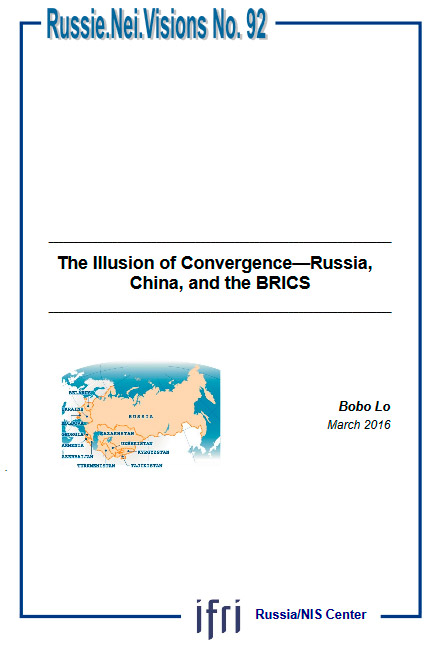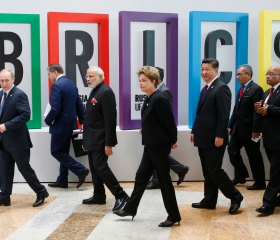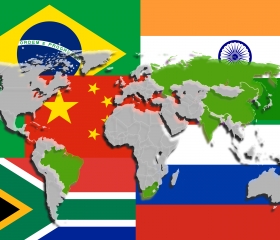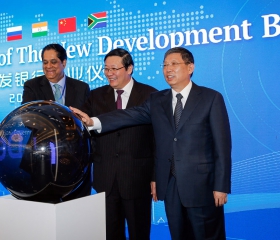Who makes BRICS more alive than BRICSers themselves
(votes: 1, rating: 4) |
(1 vote) |
PhD in History, Vice Rector, HSE University, RIAC Member
The BRICS and their possible intentions, as imagined by outside observers, continue to be a hot topic. Today skeptical analyses among the outsiders prevail, but with the understanding that any wishful thinking of the BRICS dying isn’t going to happen; they offer a rational behind BRICS, but backed up with a whole flurry of reasons why this group is going to be only a talk-shop. This is exactly what is the foundation of the analytical piece by Bobo Lo “The Illusion of Convergence – Russia, China, and the BRICS”.
Introduction
The BRICS and their possible intentions, as imagined by outside observers, continue to be a hot topic. This might seem irrelevant for the insiders themselves, who moved into a working mode after a period of initial euphoria, or rather of heightened attention and in certain ways an overestimation of the group’s abilities to pursue realistic and down-to-earth directions and options for cooperation. The outsiders started out from an outright rejection of the proper right of this group to be considered as a serious or even minimal meaningful event. A few warned against the possible challenge BRICS might pose for the old established powers. Today skeptical analyses among the outsiders prevail, but with the understanding that any wishful thinking of the BRICS dying isn’t going to happen; they offer a rational behind BRICS, but backed up with a whole flurry of reasons why this group is going to be only a talk-shop. This is exactly what is the foundation of the analytical piece by Bobo Lo “The Illusion of Convergence – Russia, China, and the BRICS”.
Limits to cooperation
The G7 found itself in a empty playing field and had to invent a totally new mechanism able to provide for follow up actions, but the G7 was never able to set up a new international body to manage its aspirations.
Probably among the most widespread and also mainstream ideas of this article is the notion that the BRICS are aiming for a new “post-American multipolar order” (without the Bretton Woods institutions and with the G5 as a primary engine for change and that future fair world) and making “very modest” progress towards that goal. On the one hand, this supposition is hardly argued by the ‘BRICSers’ themselves. Being a member of the BRICS and having high expectations and zeal for the group to start showing tangible results, there’s always a tendency to ask for more than it is possible under the given conditions.

But before analyzing the results achieved by the BRICS at present, let us take a short rewind and compare the two ‘clubs’ – the G7 and the BRICS. Since the argument concerns ‘modest progress,’ we’ll start by considering the institution-building achieved by both groups during the timeframe of the first seven years of their existence. As of today, the BRICS have established a wide network of supporting outreach mechanisms, which do not disappear with the end of the hosting year but instead evolve in accordance with the interests of each hosting member. The business and think-tank council format has existed since 2012; in fact, academic meetings became regular even before the institutionalization in the form of the BTTC, with the first being the precursor of the Yekaterinburg Summit held in 2008. Youth cooperation (during the Youth Summit, first held in Kazan and Young diplomats’ forum occurring on the sidelines of the BRICS University Forum in Moscow) also has continued during the Indian Presidency. The civil and parliamentary aspects of cooperation also launched in Russia this year have been elaborated into a number of issue-specific intense “people2people” events like the U-17 Football tournament, Film Festival, Friendship Cities Conclave – many of these ideas are based on the recommendations elaborated during civil society meetings of the BRICS countries, still acquiring special Indian (or with time the next presidency’s) flavor. All of this occurred without counting numerous official track gatherings and topical meetings of the BRICS.
Now let us see what was achieved ‘institutionally’ by the G7 during its first several years. While ministerial and other official track meetings had been part of the G7 work from the very start, it is notable to see that the finance ministers’ meetings of the Group came to include two countries, namely Italy and Canada, only 8-9 years after they had begun their actual work in the G7 on the highest level – in 1986. Nothing of this kind would be possible in BRICS, where South Africa became a full-fledged member on all levels and directions of discussion from the very start of its inclusion. Other tracks, namely civil society, according to prominent G7 scholar Peter Hajnal were recognized by the Group only in the 21st century[1]. At the same time, to be fair, one can see that business and high level expert opinions were part of the G7 from the very start.[2] In fact, researchers often name not the ‘Library group’ as the precursor of the G7, but rather the Trilateral commission with Rockefeller[3] and Brzezinski being behind the conceptual formation of such meetings.

Carolijn van Noort:
Strategic Narratives of Economic
Partnership: the Case of BRICS
and Infrastructure
The G7 found itself in a empty playing field and had to invent a totally new mechanism able to provide for follow up actions, but the G7 was never able to set up a new international body to manage its aspirations. The Bretton Woods institutions, often vested with implementation impetus, came into existence during 1944 – 1947, OECD and its specialized body on energy – IEA also appeared before the group started to meet. Among the most structured decisions were the Plaza (1985) and Louvre (1987) agreements introducing economic indicators for multilateral monitoring. Ad hoc working groups included the Nuclear Safety Task Force (established in 1992 before Munich Summit), and the Lyon TF and Expert group on non-proliferation (established in1996).[4] Also one has to bear in mind, and this is often stressed by Western experts, that the G7 presented a gathering of like-minded countries whose values and principles converged in a number of important areas like liberal democracy, market economy, and responsibility in global governance.
At the same time we now have the BRICS, supposedly lacking common principles, but still able to create and launch during the first eight years fully functional institutions like the New Development Bank and Contingency Reserve Arrangement, the adopted Strategy for Economic Partnership, and a number of Task Forces in the areas of agriculture, anti-drug cooperation, etc. It is worth mentioning that the BRICS Bank announced the disbursement of the first set of loans worth 811 million USD to support 2370 MW of renewable energy capacity in Brazil (300 million USD), China (81 million USD), India (250 million USD), and South Africa (180 million USD). More news came with the Bank issuing five-year bonds in Renminbi.[5]
National interests and ‘big brother’ visions
Nothing is wrong with having national ideas and interests behind any multilateral gathering.
It is also clear that nothing is wrong with having national ideas and interests behind any multilateral gathering, which Mr. Lo for some reason attributes as a fact of weakness of the BRICS. While this factor could undermine and probably does hinder a number of issues discussed within the group, it also constitutes the strong side of the cooperation scheme. At the time of creation, each of the Group members realized the importance of its proper relations with the countries of the West. Thus from the very start, no-one within the Group would ever claim that the BRICS were willing to supplant the current world order (which Bobo Lo offers as the view trying to be imposed by Moscow). In fact, this “attribution without knowledge of the country” infuses the whole article, when Russia, or Putin personally, either wants to “overturn the existing order”, or to praise “Putin’s personal achievements, declaring Russia a great power”.
With regards to China, to prove his point, Bobo Lo claims that Xi Jinping only devoted increased attention to the BRICS “to keep Moscow happy”. It would certainly be amusing to look into Chinese policies from the perspective of its partners and neighbors being satisfied, instead of the pragmatic approach which allowed for the country to move up from the lower tier of economic powers and become the largest economy, or at worst second largest, in today’s world. In fact, as earlier with Moscow, Mr. Lo attributes certain wishes to Beijing without giving proper validation or citation from official sources or interviews.
National interests do drive the actions and intents of any independent sovereign country. Having at times prioritized relations with either of the three centers of power of the West, all of the BRIC(S) members have found it useful to have their own mechanisms to discuss issues of South-South cooperation or build a cumulative voice where not a single member, including China, could boast independent strength or alter the collective Western or even unilateral American approach to common global problems.
Another point that looks fundamentally weak would be the assumption that the BRICS activities are only able to progress if and when there are “lasting economic, security, and geopolitical synergies between Moscow and Beijing”, and that they risk degradation under the opposite scenario. This supposition could be well applied to the Shanghai Cooperation Organization, with the two strongest members guaranteeing the stability and balance of interests of the two in the area; at least this was unquestionable before the widening of SCO membership. The BRICS wouldn’t have been able to even begin meeting, let alone function and negotiate on the establishment of the new institutions if any tone of inequality of its members was part of the deal. It is true that Russia and China are the only countries of the BRICS that are also permanent members of the UN Security Council, but it is also true that the only way for the Group to function is to achieve consensus on decisions put forward.

BRICS: Union of Reformers and National
Interests
Mr. Lo’s idea that the foundation of the BRICS lies in the bilateral relations and capacity of Russia and China is counter to reality. He doesn’t stop there, insisting that the BRICS served “as a mechanism for Sino-Russian accommodation”. The fact of life is that any stress on the advanced relations between Russia and China would make the other countries of the group uneasy, and not lead to cohesion. It is enough to recall the example of the idea of non-weaponization of outer space and see how uneasy Indians were with introducing the notion of joint Sino-Russian draft resolution for the UNSC into BRICS texts. Thus, any preference of bilateral ties and achievements are counter to what was mentioned by the author and instead should be applied with caution not to undermine the multilateral spirit of the BRICS.
The author’s insistence on the primary role of two of the five BRICS countries and the vivid descriptions of the other members (the “continuing backwardness of India”, “the near-irrelevance of South Africa”) demonstrate an approach alien to the basic principles of the BRICS and rather embrace the old colonial approach to the countries of the South from the rich North.
As mentioned earlier, national interests also encourage the existence of the BRICS, not further its demise. For the non-members of the UNSC, BRICS is an extra way to get in their full rights into global policy making, raising their international status and fostering national perspectives. It would also be wrong to assume that other similar groupings achieved full convergence of national and collective interests to act successfully. One good example would be the G7, seemingly having the closest coherence among its members and the greatest compatibility of national approaches to global problems at any time during its existence. But it was during the G7 that Europeans chose to ignore the US demand to issue sanctions against the Soviet Union in the early 1980s and halt ongoing intensive cooperation in building the Druzhba pipeline.
More questions arise with the author’s assumption that Moscow is concerned with the possible enlargement of the group since it will “dilute the exclusiveness of the BRICS”; at the same time it is common knowledge that the decision to ‘go deeper before going wider’ represents the joint view of the five countries, with cautious regional outreach practiced during each of the BRICS presidencies. If the time is ripe by the next presidency to enlarge the grouping, this would be considered, but isn’t part of the agenda at the moment.

Looking ahead and beyond
One correct point BRICS experts would totally agree with would be Bobo Lo’s statement, that “critics are sometimes guilty of wishful thinking in predicting its early demise”. It is indeed difficult to go along the optimistic line of the BRICS having already turned “into a full-fledged mechanism of comprehensive cooperation” between the five countries. Much still needs to be done. National egoism does often prevail in intra-BRICS deliberations, but this signals a standard working process characteristic of most international institutions, including such an advanced integration mechanism as the EU. ASEAN might seem to be an interesting point of comparison, but in this case rather signals an underestimation of the achievements of the South-East Asian countries’ group. It also demonstrates a lack of understanding among international expert circles of the differences between the different types of institutions, tasks and functions. While such a topic does exist as part of researchers’ deliberations on the future of the BRICS, nothing of the type of institutionalization of the Group seems either viable or even desirable for its healthy operations. BRICS is nothing more, but also nothing less than a joint venture of the countries from the outside of the cozy Golden Billion circle to bring better lives and fairness to their own peoples and to the other outsiders from the rich club, and not to run the anti-Western revolution. The grouping will evolve around interests and capacities of all of its members, not the Sino-Russian duet alone. Its pace by all means will depend on the geopolitical and economic realities that each of the states live in, which does offer ‘fluidity’ to its future, but one thing is certain about that future – the need to be heard and not discarded in the global rule-making process will ensure that BRICS or other similar mechanisms will exist and struggle through potential difficulties.
[1] Peter Hajnal calls the second period of civil society acknowledging the G7 starting in 1981 and lasting till 1994. This period commanded more attention from civil society and trade unions towards the G7 gatherings. The first Alternative Summit organized by the TOES/UK Foundation was held parallel to the G7 meeting in 1984. At the same time, recognition on the part of the G7 came only in Halifax in 1995, when it pledged to hold consultations with “international organizations, bilateral donors and NGOs”. The first ever series of meetings of the G8 with civil society occurred during the Russian Presidency in 2006 when all nine Sherpas came to the conference to talk to civil society representatives, later they had a meeting with representatives of this process in Kazan, and it all peaked with the arrival of President Putin to talk to over a thousand participants of the final pre-summit civil conference.
[2] May 1980 saw an informal business mini-summit in London to review leaders’ agenda for the Venice meeting; the International Chamber of Commerce (ICC-WBO) comes out with annual appeals to the G7/G8 leaders since 1999; there were instances of consultations with national businesses while preparing the agenda, but what’s even more important – Tony Blair came out with the 2005 Gleaneagles Summit issues at Davos Forum. (Peter Hajnal, The G8 and the G20: evolution, role, documentation. Moscow, Logos, 2008, pp. 135-137)
[3] In fact David Rockefeller tried to achieve success of such an inter-regional trilateral coordination mechanism back in 1960s within banking and wider big business circles.
[4] The detailed report on institution building within the G7/G8 can be found in V.V.Panova, “Multilateral mechanisms of cooperation of advanced economies – the G8, 1975 – 2002”, Moscow, MGIMO-University Press, 2004.
[5] The BRICS Bank announced its first set of loans. The BRICS Post. April 16, 2016, http://thebricspost.com/brics-bank-announces-first-set-of-loans/#.VxOmvTCLRnJ
(votes: 1, rating: 4) |
(1 vote) |





